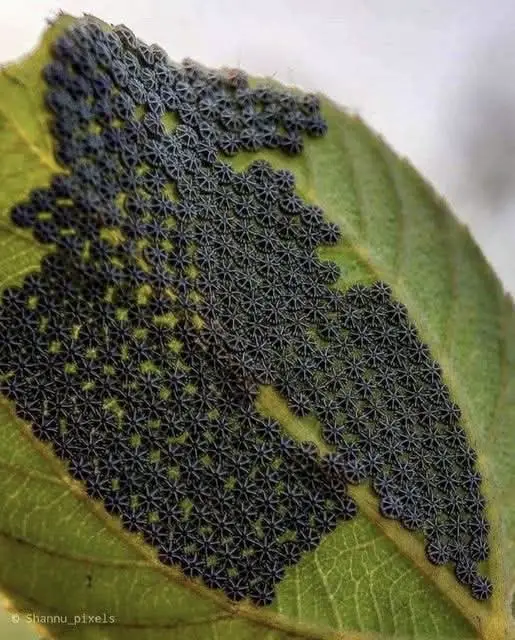🦋 Don’t Touch These If You See Them on Your Plants: The Fascinating Truth About Mourning Cloak Butterfly Eggs
Have you ever spotted tiny, dark clusters on your garden plants and wondered what they were? At first glance, they might seem like a plant disease or some alien formation. But these intricate patterns are actually the eggs of the Mourning Cloak butterfly (Nymphalis antiopa), a species that plays a beneficial role in our ecosystem.Menunkatuck Audubon Society+3Wikipedia+3Bug News+3
🌿 What Are These Mysterious Clusters?
The Mourning Cloak butterfly lays its eggs in groups of 300–450 on the twigs of host plants, particularly where buds are newly opening. These eggs are yellow and ribbed when first laid, turning black as they mature. When you see these clusters, it’s a sign that nature is at work in your garden.NC State Extension+2UMass Center for Agriculture and Food+2Wikipedia+2
🐛 Meet the Spiny Elm Caterpillar
Once hatched, the larvae—known as spiny elm caterpillars—emerge. They are black with tiny white spots and have spiny, bristly bodies, featuring a row of eight red spots along their backs. Despite their intimidating appearance, these caterpillars are harmless to humans. They feed together in groups, typically consuming leaves one branch at a time, and prefer trees like willows, elms, and poplars. Menunkatuck Audubon Society+7UMass Center for Agriculture and Food+7UC IPM+7Menunkatuck Audubon Society+3Homemaking.com+3UMass Center for Agriculture and Food+3
🦋 The Transformation into a Butterfly
After feeding and growing for about 5 to 6 weeks, the caterpillars find a safe place to pupate. They hang from a twig and form a chrysalis, which resembles a mottled, brown, dead leaf. This stage lasts approximately a week, after which the adult Mourning Cloak butterfly emerges. These butterflies are known for their dark, velvety wings bordered with a bright yellow edge and adorned with blue spots.nosleepingdogs+7NC State Extension+7Wikipedia+7
🌼 Why You Shouldn’t Disturb Them
While it’s natural to be concerned about caterpillars in your garden, the Mourning Cloak butterfly is beneficial. The caterpillars’ feeding habits typically don’t harm healthy trees, and the butterflies themselves contribute to the ecosystem by feeding on rotting fruit and aiding in decomposition. Moreover, observing their life cycle can be a rewarding experience for any nature enthusiast.Homemaking.com
🛑 Safety Precautions
Although the spiny elm caterpillars are harmless, their spines can irritate human skin. It’s advisable to avoid handling them directly. If you need to move them, use gloves or gently relocate them to a suitable tree or shrub. Reddit+6UC IPM+6Bug News+6
🌍 Embracing Nature in Your Garden
Gardening is about balance and coexisting with the creatures that share our space. By allowing the Mourning Cloak butterfly to complete its life cycle in your garden, you’re supporting biodiversity and contributing to a healthier environment. So next time you see those mysterious clusters, take a moment to appreciate the wonder of nature unfolding right before your eyes.








Your comment is awaiting moderation.
Hmm is anyone else encountering problems with the pictures on this blog loading? I’m trying to determine if its a problem on my end or if it’s the blog. Any responses would be greatly appreciated.